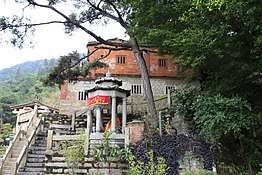Chinese Manichaeism
 |
|
Western Eastern |
|
Syrian-Egyptian Samaritan Baptist sects Alexandrian Roman Christian Gnosticism Modern |
Chinese Manichaeism is the form of Manichaeism (摩尼教 Móníjiào or 明教 Míngjiào, "bright religion") transmitted and practiced in China.
Chinese Manichaeism identifies as a teaching with the purpose of awakening (佛 fú), and it is a monotheism worshipping the universal God (Shangdi, Míngzūn 明尊 "Radiant Lord" or Zhēnshén 真神 "True God"). Creation is the Living Spirit (淨活風 Jìnghuófēng) of God, of whom there have been many manifestations in human form, including Mani (摩尼 Móní).[1]
History
Manichaeism was introduced into China in the Tang dynasty,[2] through Central Asian communities.[2] It never rose to prominence, and was officially banned and persecuted through the suppression of non-Chinese religions started by the Emperor Wuzong of Tang.
Since its introduction, Manichaeism was deeply sinicised in its style, adapting to the Chinese cultural context.[3] After the Tang, Manichaeism survived among the population and had a profound influence on the tradition of the Chinese folk religious sects integrating with the Maitreyan beliefs.[4]
Present-day Manichaeism
In modern China, Manichaean groups are still active in southern provinces, especially in Quanzhou[5] and around the Cao'an, the only Manichaean temple that has survived until today.[6] There is a Chinese Manichaean Council with representatives in Tibet and Beijing.
See also
References
- ↑ Dr. Char Yar. "Monijiao (Manichaeism) in China". academia.edu. Lecture presented at the Worldwide Conference for Historical Research, 2012.
- 1 2 Ma (2011), p. 55-56.
- ↑ Ma (2011), p. 56.
- ↑ Ma (2011), p. 19-56.
- ↑ Jennifer Marie Dan. Manichaeism and its Spread into China. University of Tennessee, 2002. pp. 17-18
- ↑ Wearring (2006), p. 260.
Sources
- Wearring, Andrew (2006). "Manichaean Studies in the 21st Century". Through a Glass Darkly: Reflections on the Sacred. Sydney University Press. ISSN 1444-5158.
- Ma, Xisha; Huiying Meng (2011). Popular Religion and Shamanism. Brill. ISBN 9004174559.

